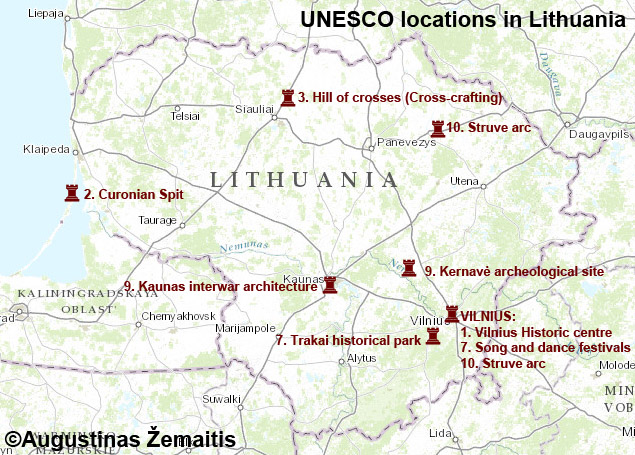UNESCO sites in Lithuania
Lithuania has 4 UNESCO heritage sites, 3 inscriptions of its art and traditions in UNESCO immaterial world heritage, 1 site on the UNESCO tentative list, 1 suggested UNESCO site, and 1 inscription in UNESCO Memory of the World. Some of the sites are great for anchoring your trip, but others may have only historical importance that is hard to understand today. Here is the full list:
1.Vilnius Historic Centre. Vilnius was once the capital of Europe's largest medieval state and its large Old Town testifies its former glory with its narrow streets, Baroque church spires, and palaces of the nobility. UNESCO world heritage.
2.Curonian Spit. The most famous natural location of Lithuania the 98 km long narrow peninsula combines the Lithuanian Sahara (massive sand dunes), pristine pine forests and some of the country's top seaside resorts. UNESCO world heritage.
3.Cross-crafting and its symbolism. While Lithuanians were Europe's final pagan country they have successfully absorbed Christian tradition into their ethnic art giving birth to the unique wooden crosses and chapel posts. Originally they adorned every yard and roadside, then many were destroyed by the Soviets but some were rebuilt in the 1990s. The best place to see the tradition is undoubtedly the constantly growing Hill of Crosses where hundreds of thousands of crosses and chapelposts have been erected by ordinary people ever since the mid-19th century. UNESCO immaterial world heritage.
4.The Baltic Way - Human Chain Linking Three States in Their Drive for Freedom. 700 km long human chain amassed some 2 million people linking Vilnius to Riga and Tallinn, some third of total Baltic populations. This demonstrated a massive will of the Baltic States to achieve freedom from the Soviet Union. It inspired similar human chains elsewhere in places like Taiwan and Israel, but neither the length nor size of the Baltic Way was ever surpassed. UNESCO memory of the world.
5.Baltic song and dance celebrations. Every 4 years, choirs from all over Lithuania and the Lithuanian diaspora are invited to Vilnius to sing Lithuanian songs together. Songs have even triggered political changes in Lithuania (the Lithuanian 1990 independence has been called the "Singing revolution"). Witnessing the Song Festival's "Day of the Songs" with a parade and performance of some 30 000 singers is a powerful experience. If visiting at another time you may still check the stand in Vilnius Vingis park where these events are held. UNESCO immaterial world heritage.
6.Sutartinės, Lithuanian multipart songs. The singers of these unique folk songs sing different lyrics at the same time, creating an interesting result. They used to be sung during the yearly farm works such as harvest but since machinery has replaced human labor there sutartinės have moved to folk music concerts. "Skamba skamba kankliai" held annually the final week of May in Vilnius is one of the festivals where you could hear them. UNESCO immaterial world heritage.
7.Trakai Historical National Park. The renovated Trakai medieval island castle is the sole water castle in Eastern Europe as well as one of the top iconic Lithuanian picture sights. UNESCO world heritage tentative list.
8.The interwar architecture of Kaunas. Kaunas uniquely had its major phase of development in the interwar period. That's because while Vilnius was occupied by Poland, Kaunas served as the Lithuanian capital. As such, it has great amounts of top interwar architecture swiftly build to turn a former Russian military outpost into Lithuania's top city. UNESCO world heritage.
9.Kernavė Archeological Site (Cultural Reserve of Kernavė). The location of the first known pagan capital of medieval Lithuania it has an aura, archeology museum, and hills once crowned by wooden castles. The medieval city itself, however, has turned into dust, replaced by an unappealing modern village. UNESCO world heritage.
10.Struve Geodetic Arc. The least interesting among Lithuanian UNESCO sites the system of small marks has been used by geographer Friedrich Georg Wilhelm von Struve to measure the meridian length. Three marks in Lithuanian territory are officially guarded. UNESCO world heritage.

Map of the top 10 UNESCO locations in Lithuania. ©Augustinas Žemaitis.












Leave a comment